Construction of a Real-Time Forecast Model for Coastal Engineering and Processes Nested in a Basin Scale Model
Abstract
1. Introduction
2. Methods
2.1. Delft3D
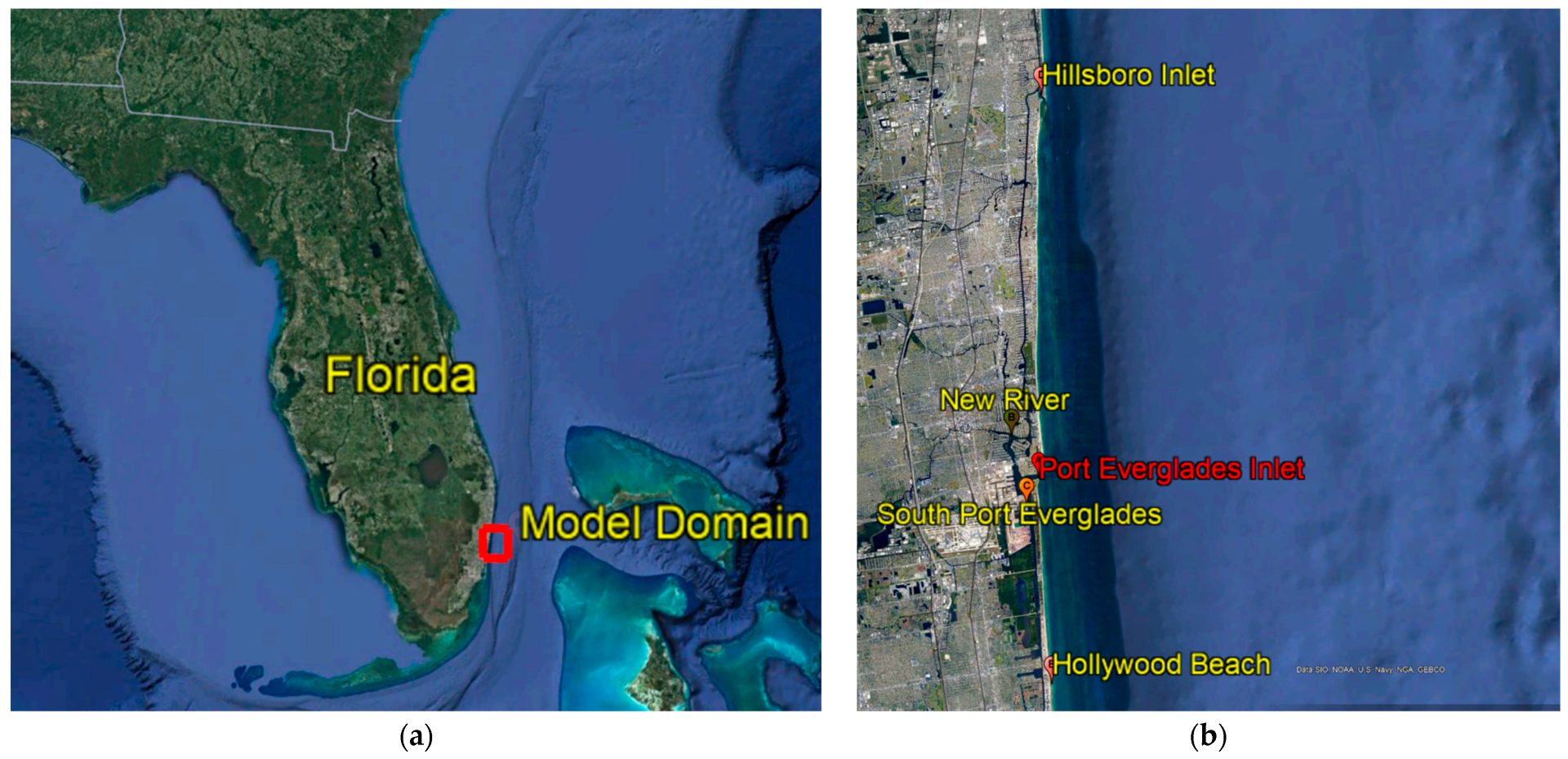
2.2. Study Area
2.3. Model Grid
2.4. Data Sources
2.5. Topography
2.6. Vertical Layer Distribution
2.7. Bottom Roughness
2.8. Flow Boundary Conditions
2.9. Transport Boundary Conditions
2.10. Meteorological Forcing
3. Model Adjustments and Calibration
3.1. Bottom Roughness
3.2. Five- vs. Ten-Layer Simulations
3.3. Uniform (1-D) vs. 2-D Winds
3.4. HYCOM vs. ADCIRC Model Data
4. Model Performance and Skills
4.1. Water Level
4.2. Salinity and Temperature
4.3. Tide and Tidal Constituents
4.4. Non Tidal Flow
5. Real-Time Forecast
6. Discussion and Conclusions
Supplementary Materials
Author Contributions
Funding
Institutional Review Board Statement
Informed Consent Statement
Data Availability Statement
Acknowledgments
Conflicts of Interest
Appendix A
References
- Auclair, F.; Estournel, C.; Marsaleix, P.; Pairaud, I. On coastal ocean embedded modeling. Geophys. Res. Lett. 2006, 33, 14. [Google Scholar] [CrossRef]
- Beckers, J.M.; Brasseur, P.; Nihoul, J. Circulation of the western mediterranean: From global to regional scales. Deep Sea Res. Part II Top. Stud. Oceanogr. 1997, 44, 531–549. [Google Scholar] [CrossRef]
- Cailleau, S.; Fedorenko, V.; Barnier, B.; Blayo, E.; Debreu, L. Comparison of different numerical methods used to handle the open boundary of a regional ocean circulation model of the Bay of Biscay. Ocean Model. 2008, 25, 1–16. [Google Scholar] [CrossRef]
- Penven, P.; Debreu, L.; Marchesiello, P.; McWilliams, J.C. Evaluation and application of the ROMS 1-way embedding procedure to the central California upwelling system. Ocean Model. 2006, 12, 157–187. [Google Scholar] [CrossRef]
- Katavouta, A.; Thompson, K. Downscaling Ocean conditions: Experiments with a quasi-geostrophic model. Ocean Model. 2013, 72, 231–241. [Google Scholar] [CrossRef]
- Katavouta, A.; Thompson, K.R.; Lu, Y.; Loder, J.W. Interaction between the tidal and seasonal variability of the Gulf of Maine and Scotian shelf region. J. Phys. Oceanogr. 2016, 46, 3279–3298. [Google Scholar] [CrossRef]
- Ezer, T.; Atkinson, L.P.; Corlett, W.B.; Blanco, J.L. Gulf stream’s induced sea level rise and variability along the us mid-Atlantic coast. J. Geophys. Res. Ocean 2013, 118, 685–697. [Google Scholar] [CrossRef]
- Tomczak, M. Shelf and Coastal Oceanography; University of Maine: Orono, ME, USA, 1998. [Google Scholar]
- Deltares, D. Simulation of Multi-Dimensional Hydrodynamic Flows and Transport Phenomena, Including Sediments; Version 4.05; Delft3D-Flow User Manual: Delft, The Netherlands, 2022. Available online: https://oss.deltares.nl/web/delft3d/manuals (accessed on 16 February 2023).
- Google Earth, Version 9.185.0.0. Port Everglades, Florida, USA. Available online: https://earth.google.com (accessed on 20 March 2023).
- NOAA National Geophysical Data Center. 1/3 Arc-Second MHW Coastal Digital Elevation Model; NOAA National Centers for Environmental Information: Palm Beach, FL, USA, 2010. Available online: https://www.ncei.noaa.gov/access/metadata/landing-page/bin/iso?id=gov.noaa.ngdc.mgg.dem:427 (accessed on 25 April 2018).
- Leendertse, J.J. Aspects of a Computational Model for Long-Period Water-Wave Propagation; RAND Corp.: Santa Monica, CA, USA, 1967. [Google Scholar]
- Leendertse, J.J.; Gritton, E.C. A Water-Quality Simulation Model for Well Mixed Estuaries and Coastal Seas: Volume II: Computation Procedures; RAND Corp.: Santa Monica, CA, USA, 1971; p. 53. [Google Scholar]
- Leendertse, J.J.; Alexander, R.C.; Liu, S.K. A Three-Dimensional Model for Estuaries and Coastal Seas: Volume I, Principles of Computation; RAND Corp.: Santa Monica, CA, USA, 1973. [Google Scholar]
- Verboom, G.K.; Slob, A. Weakly reflective boundary conditions for two-dimensional shallow water flow problems. Adv. Water Resour. 1984, 7, 192–197. [Google Scholar] [CrossRef]
- Verboom, G.K.; Segal, A. Weakly-reflective boundary conditions for shallow water equations. In Research in Numerical Fluid Mechanics; Vieweg+Teubner Verlag: Wiesbaden, Germany, 1987. [Google Scholar]
- Metzger, E.J.; Helber, R.W.; Hogan, P.J.; Posey, P.G.; Thoppil, P.G.; Townsend, T.L.; Wallcraft, A.J.; Smedstad, O.M.; Franklin, D.S.; Zamudo-Lopez, L.; et al. Global Ocean Forecast System 3.1 Validation Testing; NRL Report; Naval Research Lab Stennis Detachment: Stennis Space Center, MS, USA, 2017; NRL/MR/7320--17-9722. Available online: https://hycom.org (accessed on 24 March 2023).
- Mesinger, F.; DiMego, G.; Kalnay, E.; Mitchell, K.; Shafran, P.C.; Ebisuzaki, W.; Jović, D.; Woollen, J.; Rogers, E.; Berbery, E.H.; et al. North American Regional Reanalysis: A long-term, consistent, high-resolution climate dataset for the North American domain, as a major improvement upon the earlier global reanalysis datasets in both resolution and accuracy. Bull. Am. Meteorol. Soc. 2006, 87, 343–360. [Google Scholar] [CrossRef]
- Octavio, K.A.H.; Jirka, G.H.; Harleman, D.R.F. Vertical Heat Transport Mechanisms in Lakes and Reservoirs. Ph.D. Thesis, Massachusetts Institute of Technology, Cambridge, MA, USA, 1977. [Google Scholar]
- NOAA Tides and Currents. South Port Everglades, FL—Station ID: 8722956. Available online: https://tidesandcurrents.noaa.gov/waterlevels.html?id=8722956 (accessed on 5 June 2018).
- Real Time Florida Coastal Guidance. East Central Coast, Indian River Lagoon, and Brevard County. Available online: https://fl-asgs.github.io/ECFL-IRL/ (accessed on 27 July 2018).
- Pawlowicz, R.; Beardsley, B.; Lentz, S. Classical tidal harmonic analysis including error estimates in MATLAB using T_TIDE. Comput. Geosci. 2002, 28, 929–937. [Google Scholar] [CrossRef]
- NOAA. North American Mesoscale Forecast System (NAM). Available online: https://registry.opendata.aws/noaa-nam (accessed on 24 March 2023).
- Stelling, G.S. On the Construction of Computational Methods for Shallow Water Flow Problems. Ph.D. Thesis, Rijkswaterstaat, Utrecht, The Netherlands, 1983. [Google Scholar]
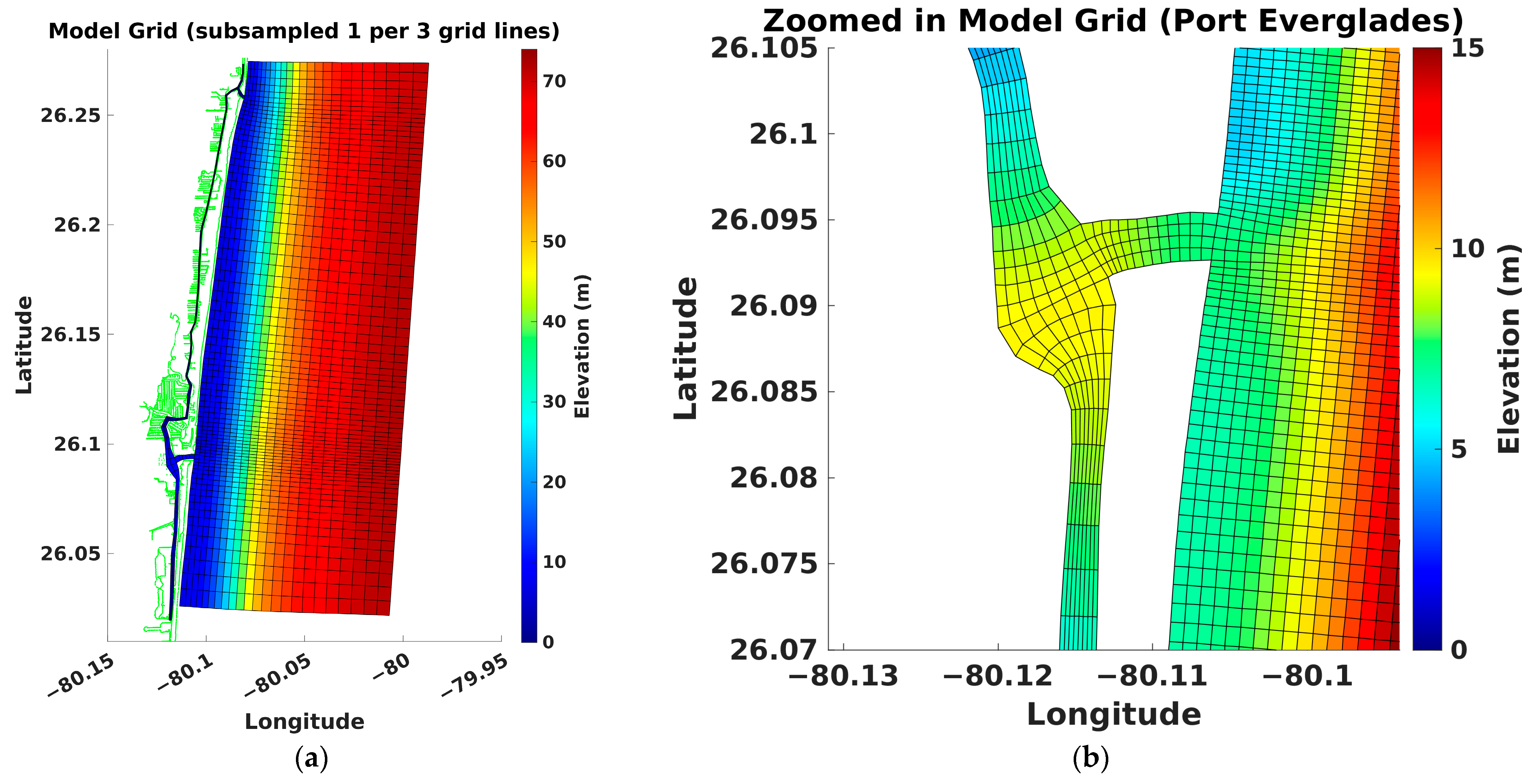

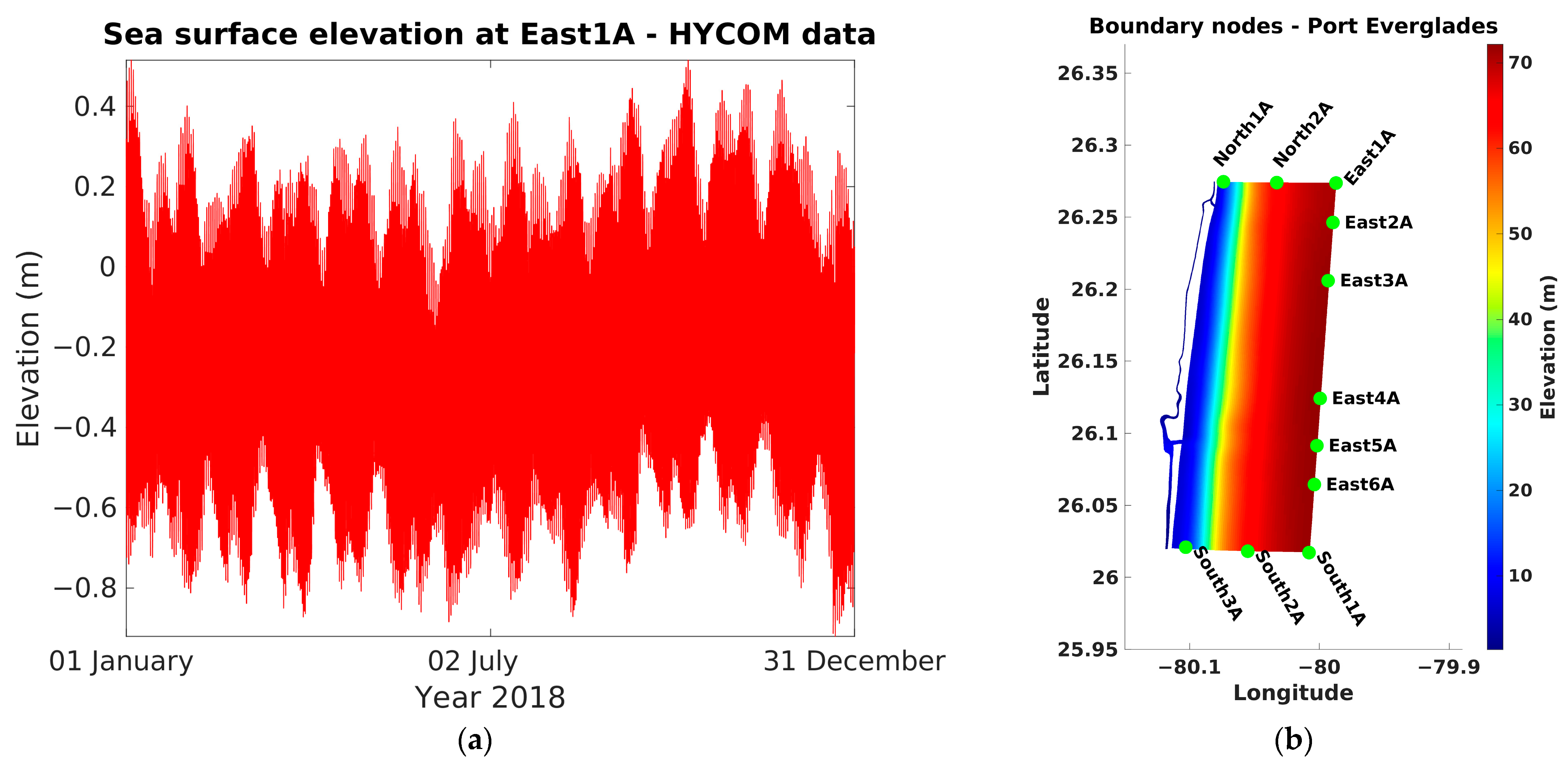
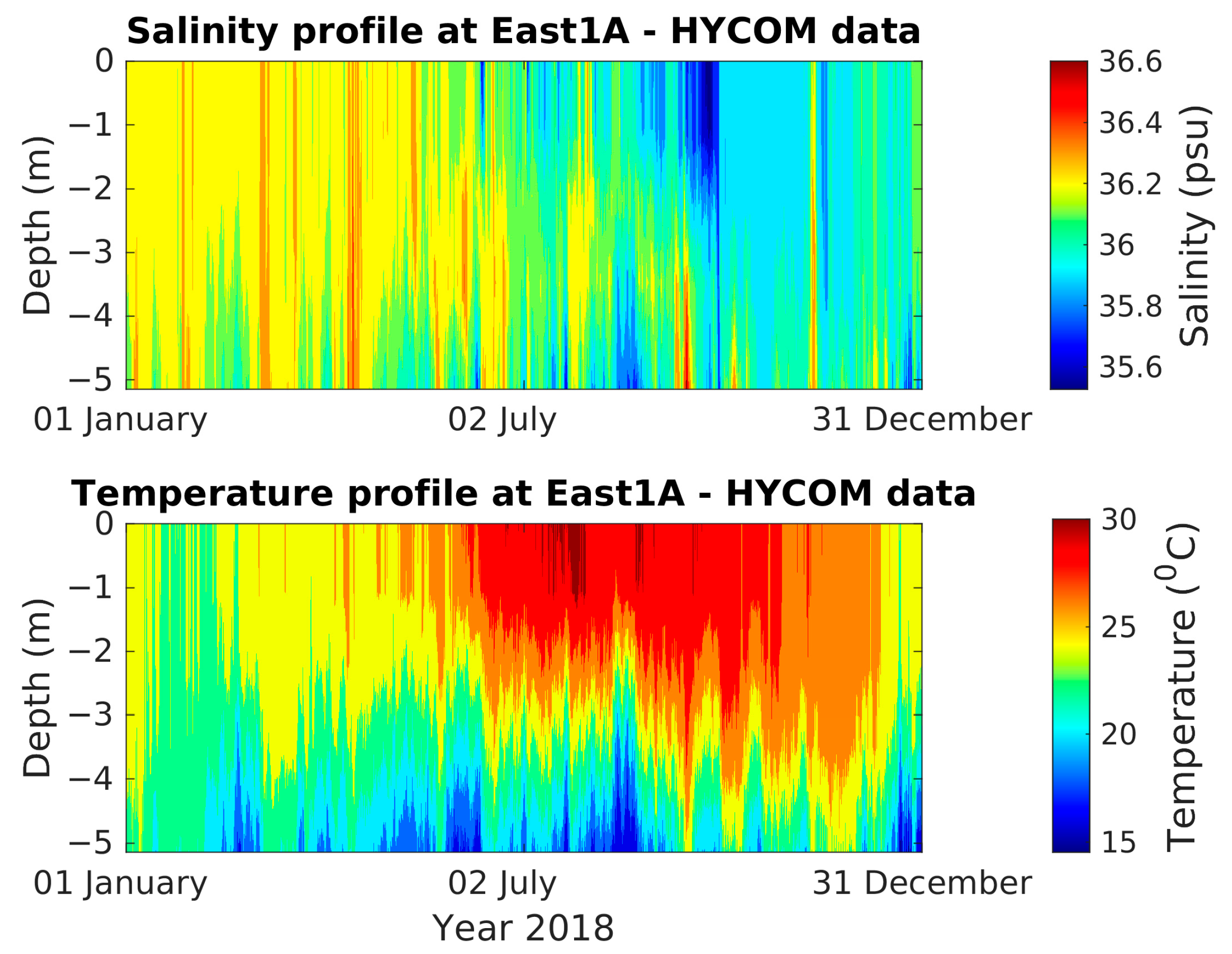
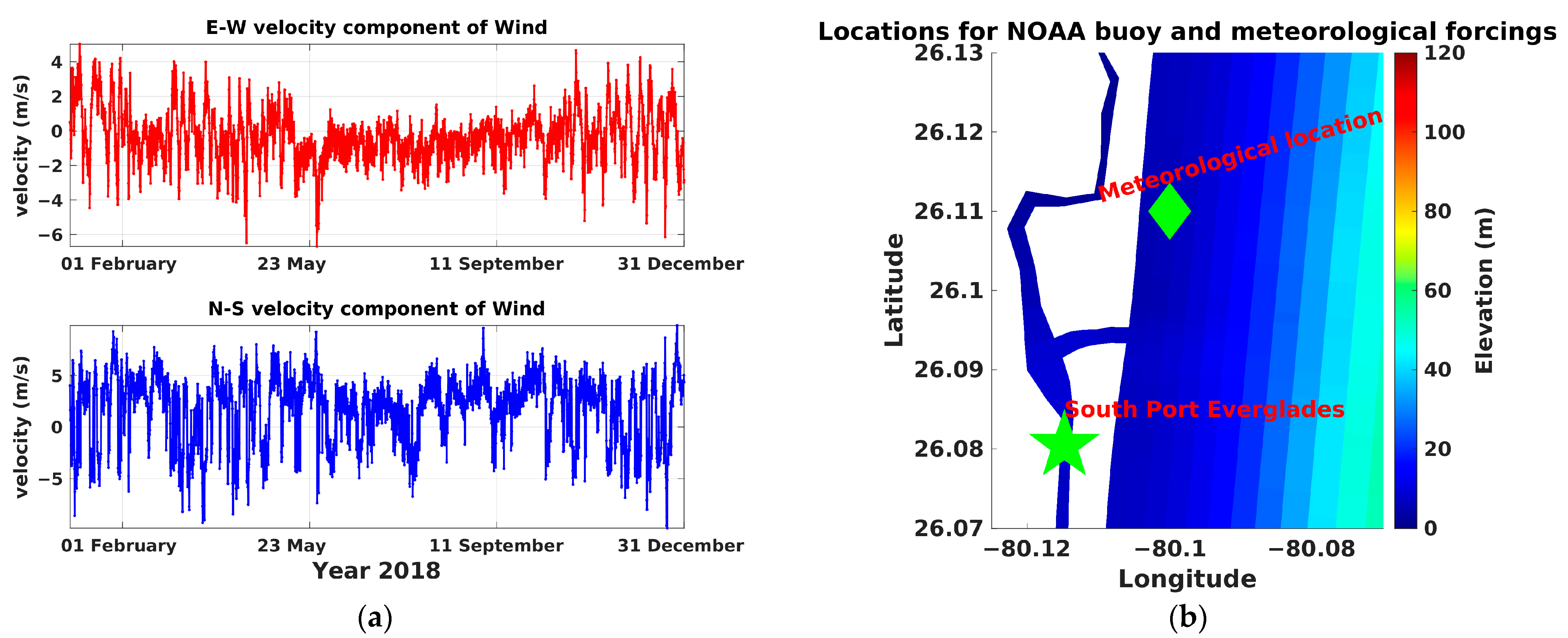
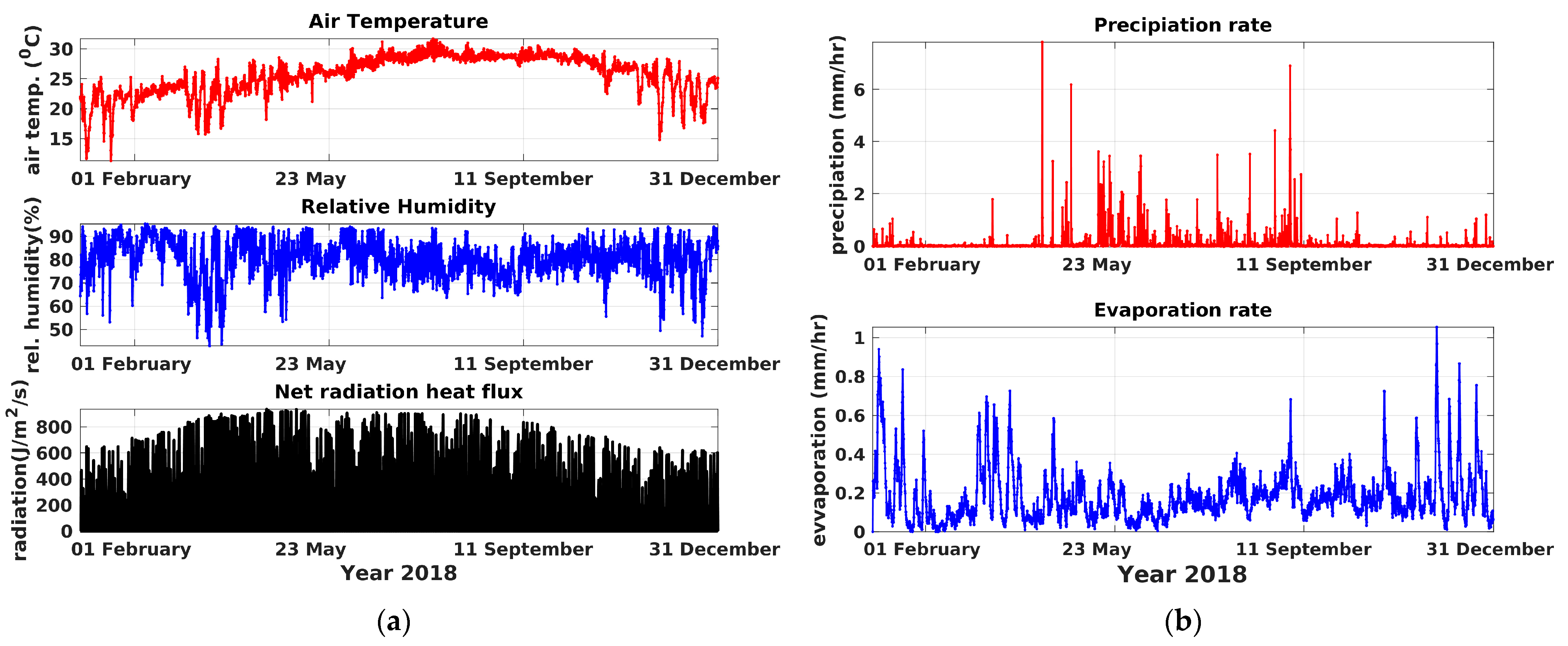
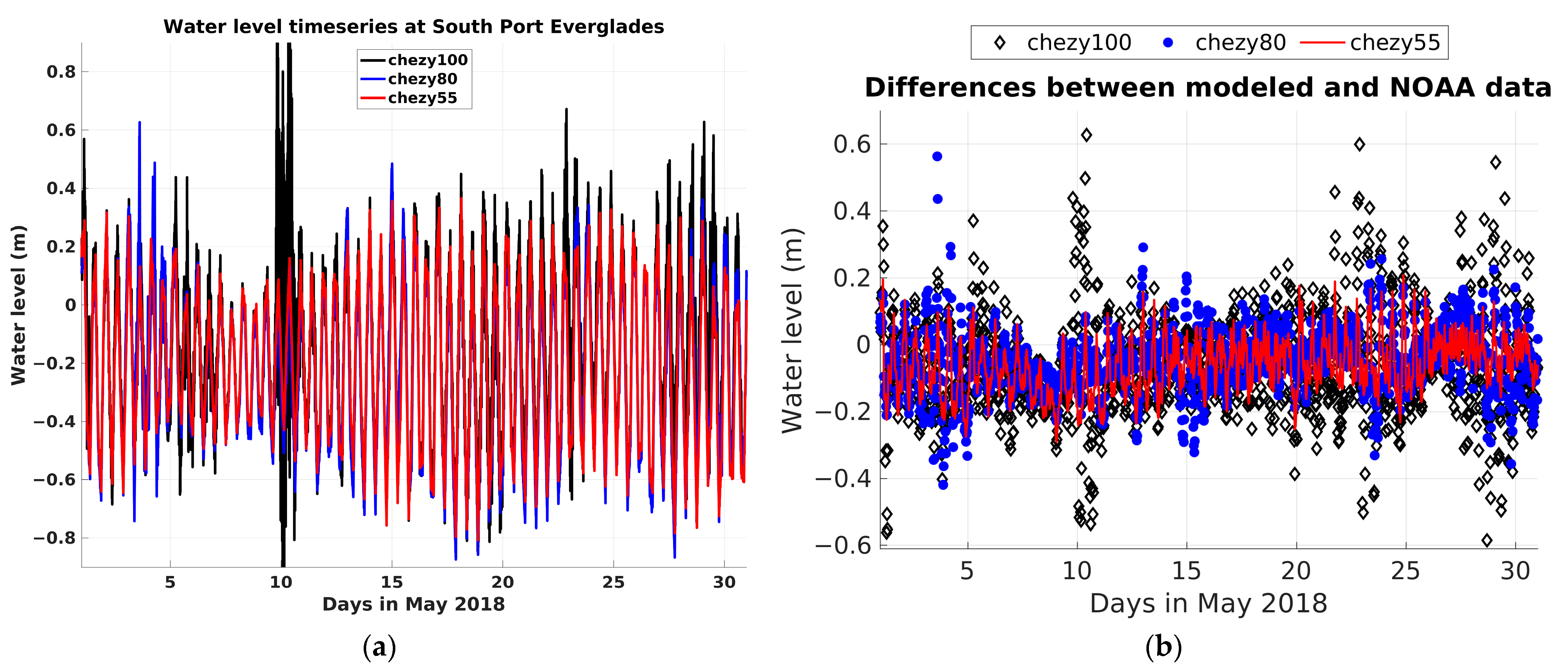
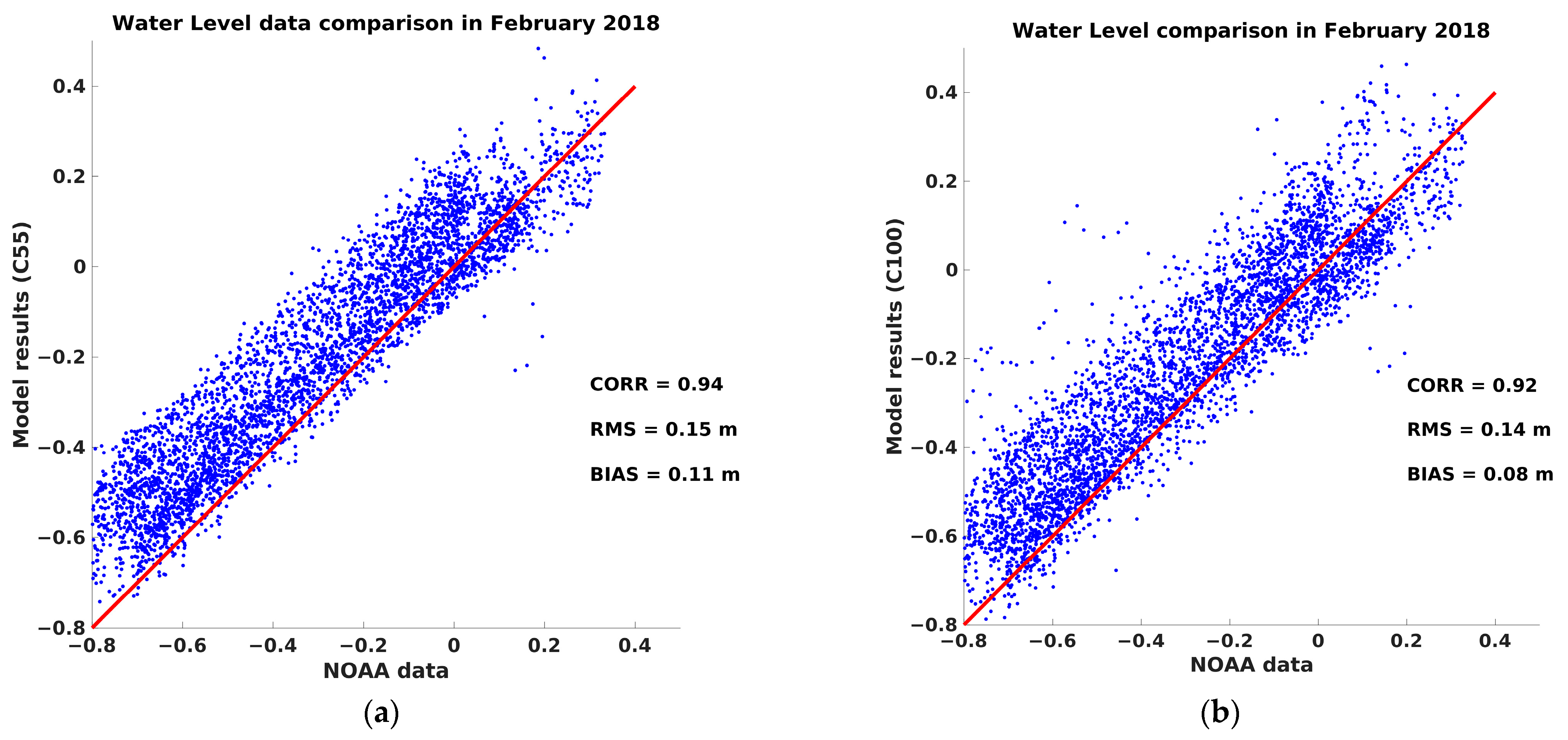
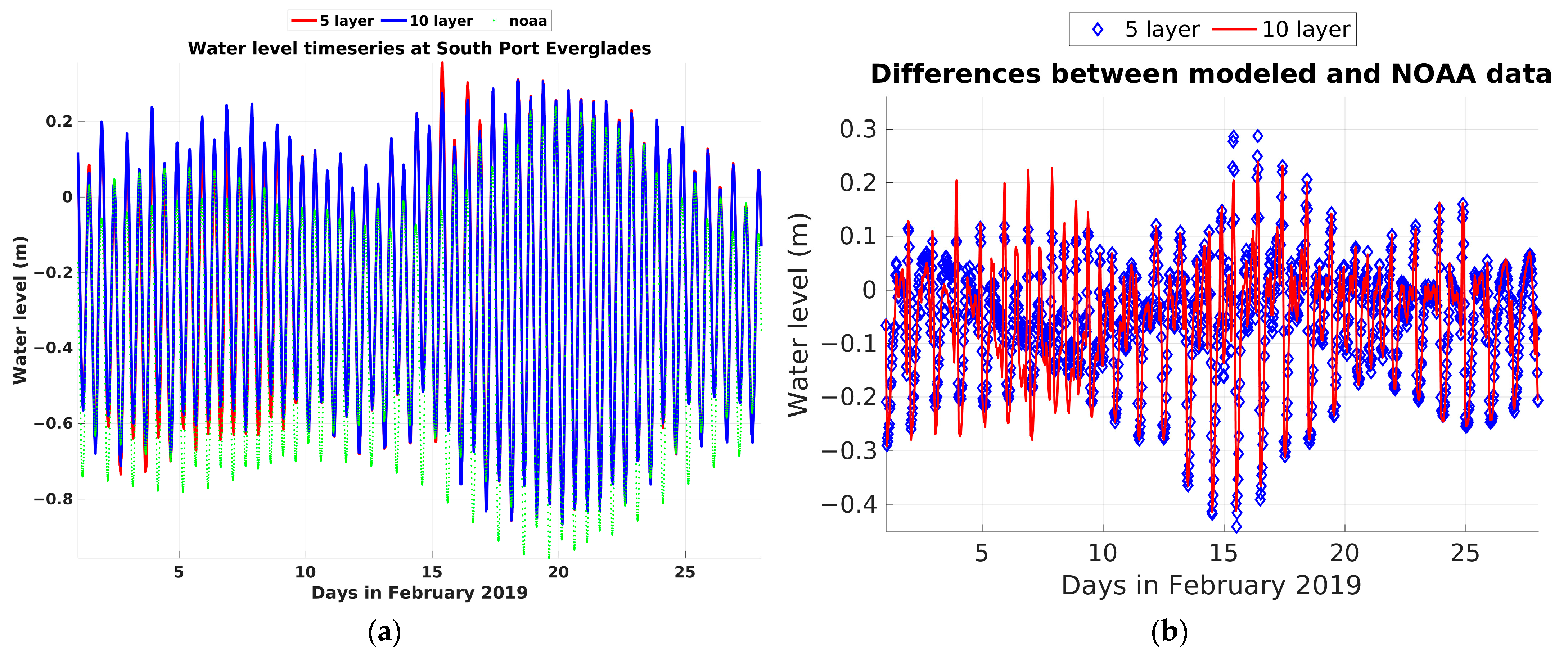
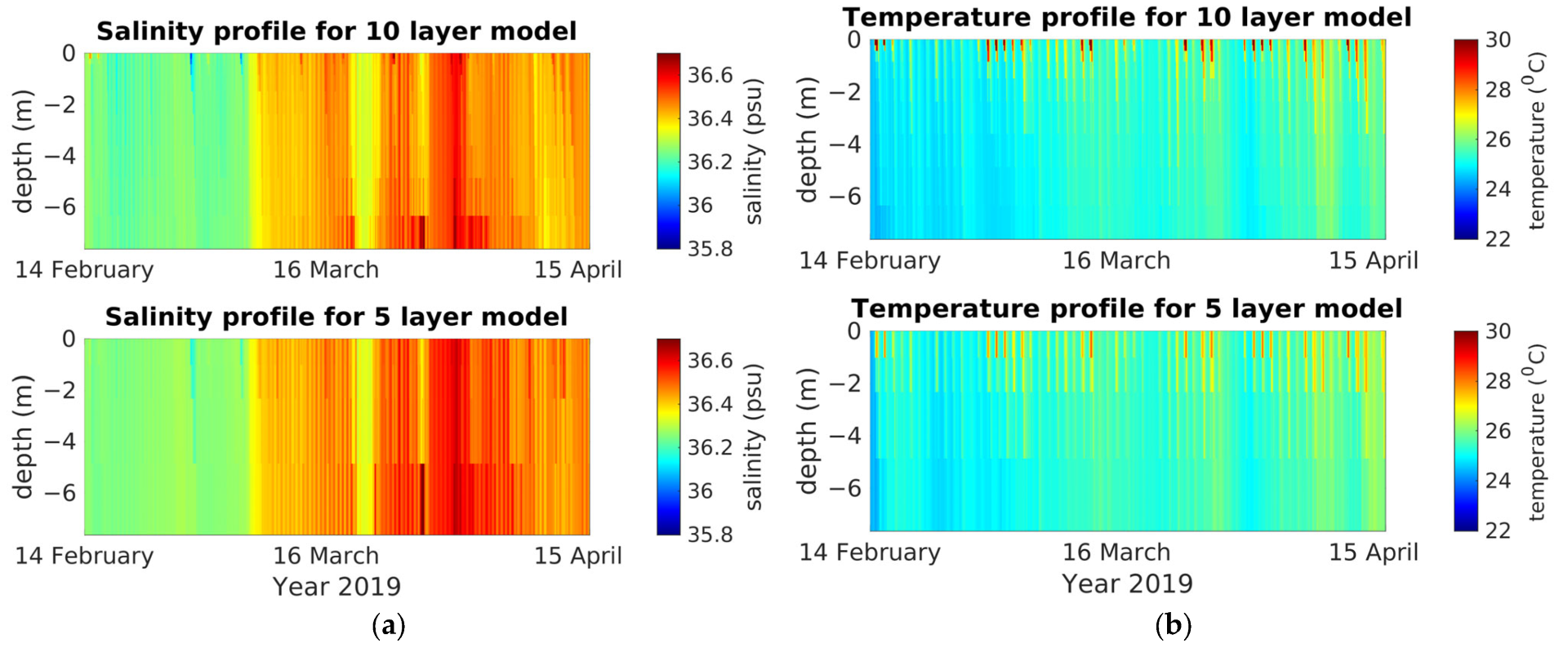
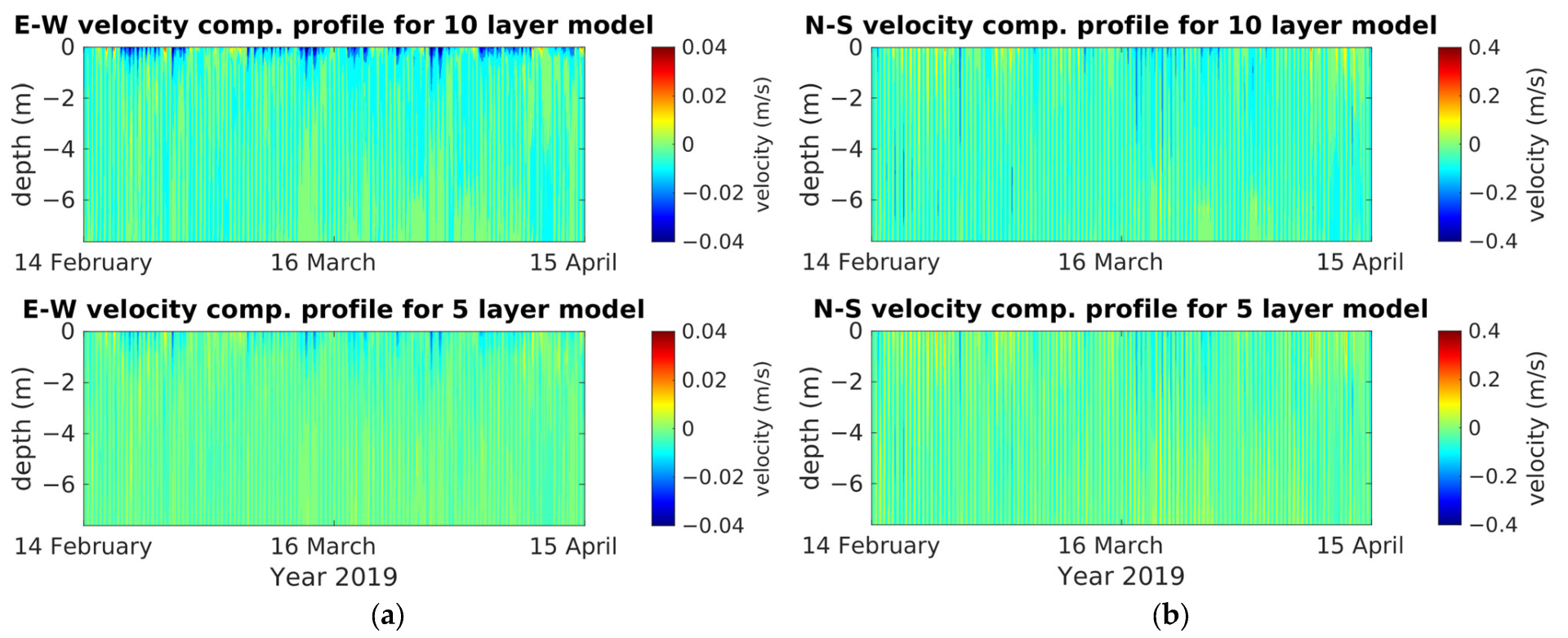
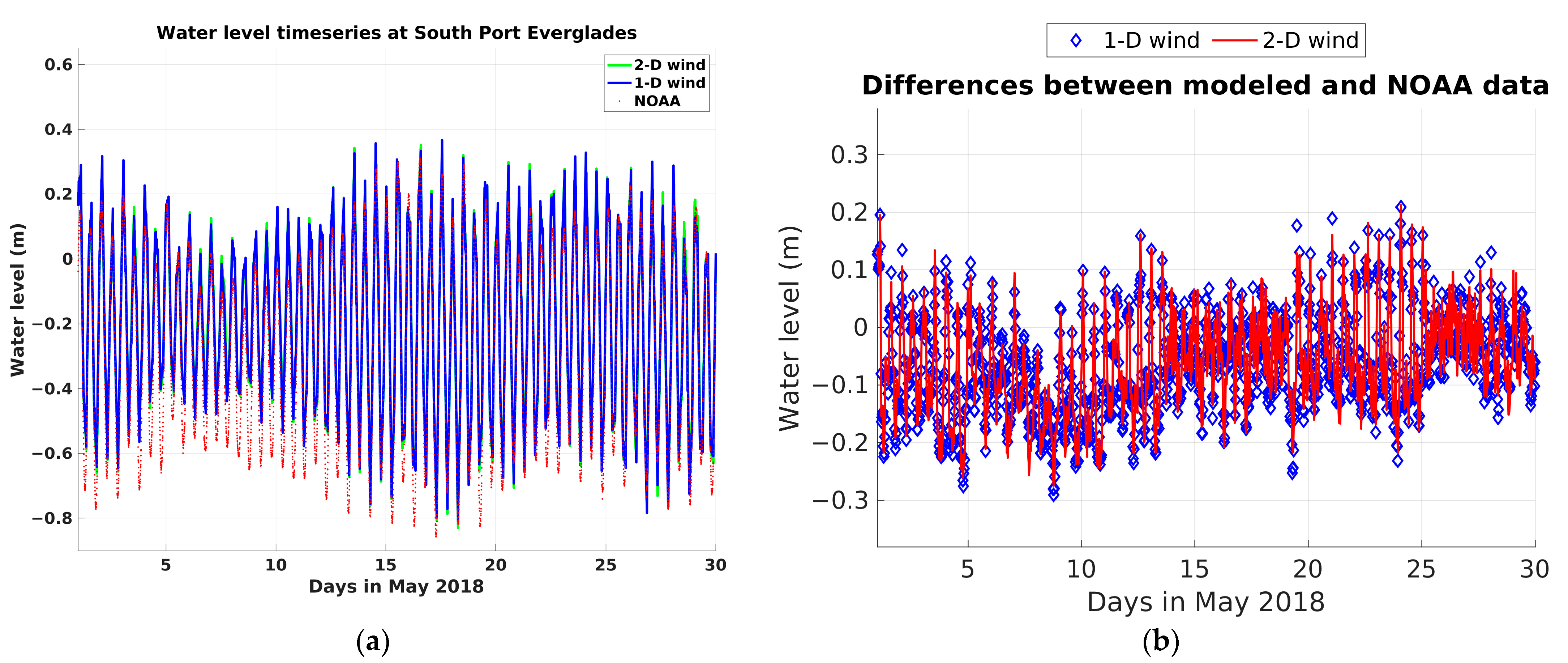
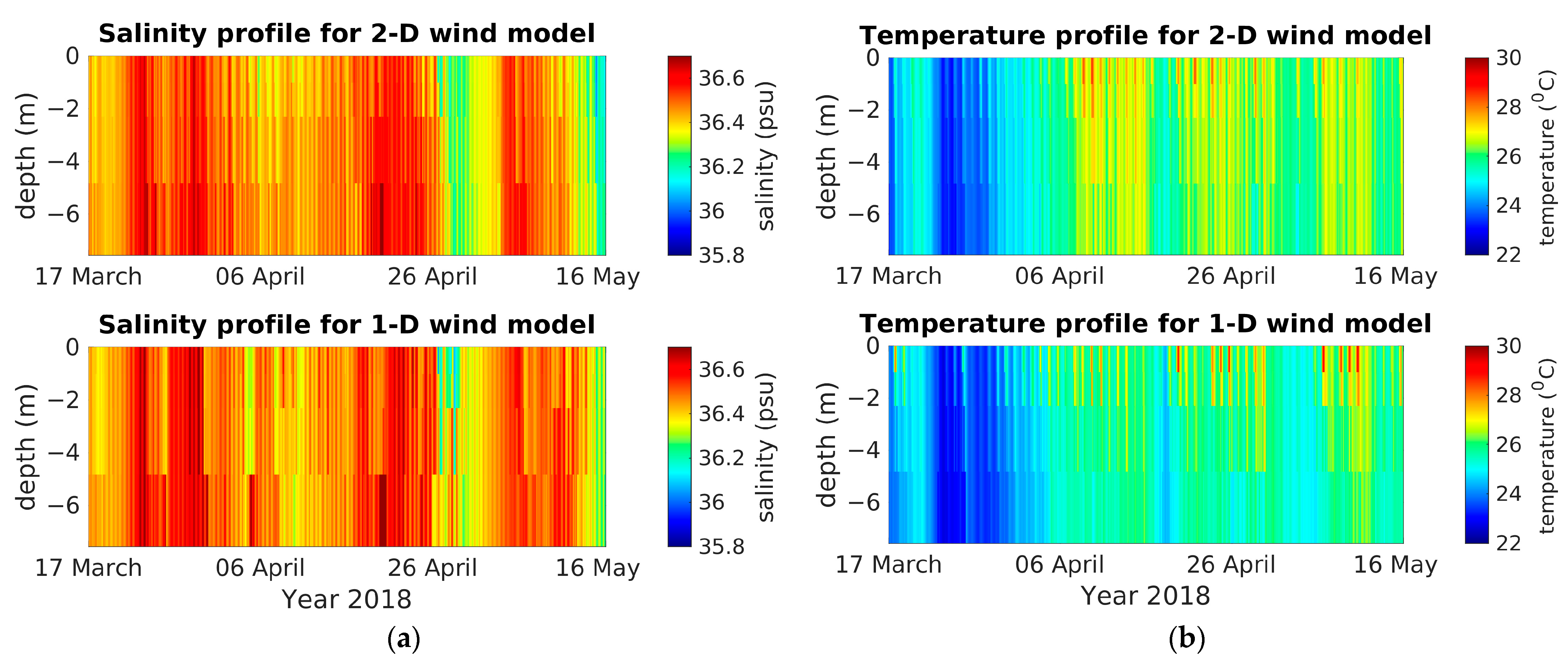
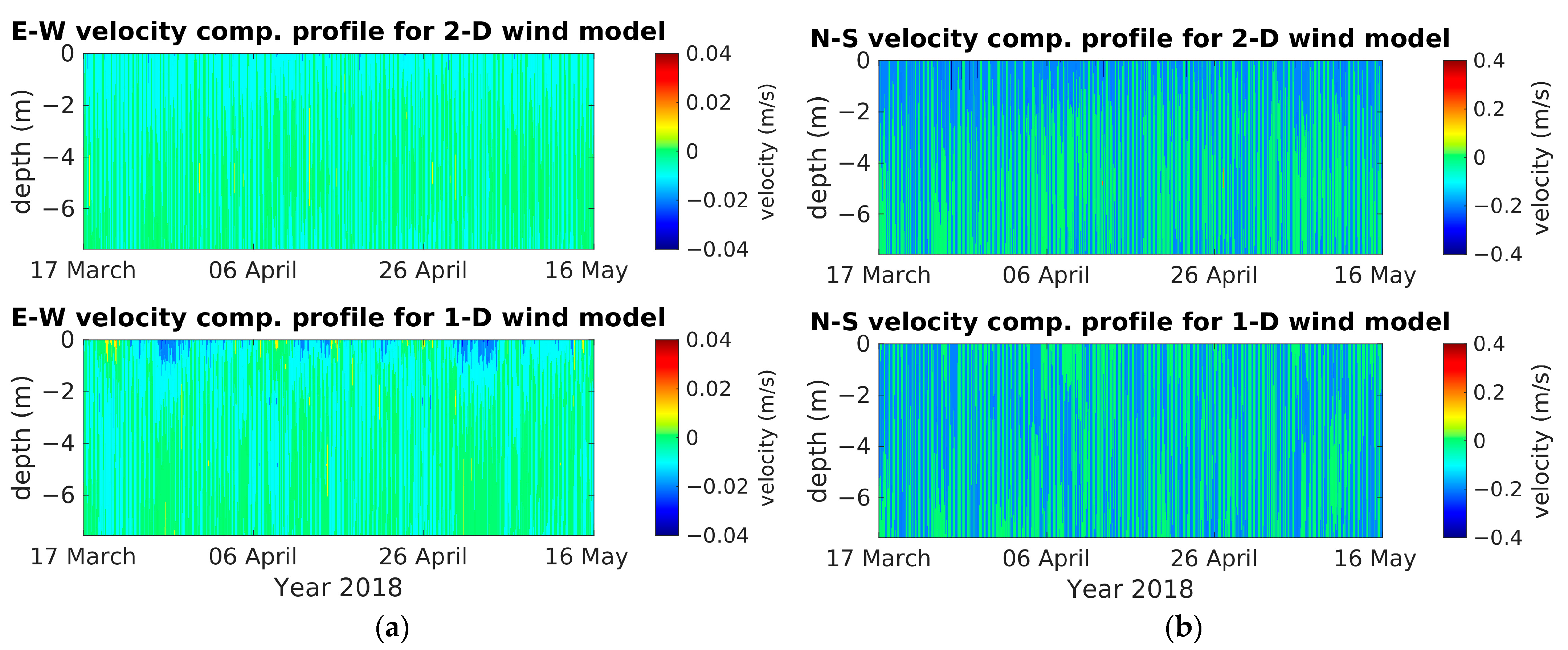

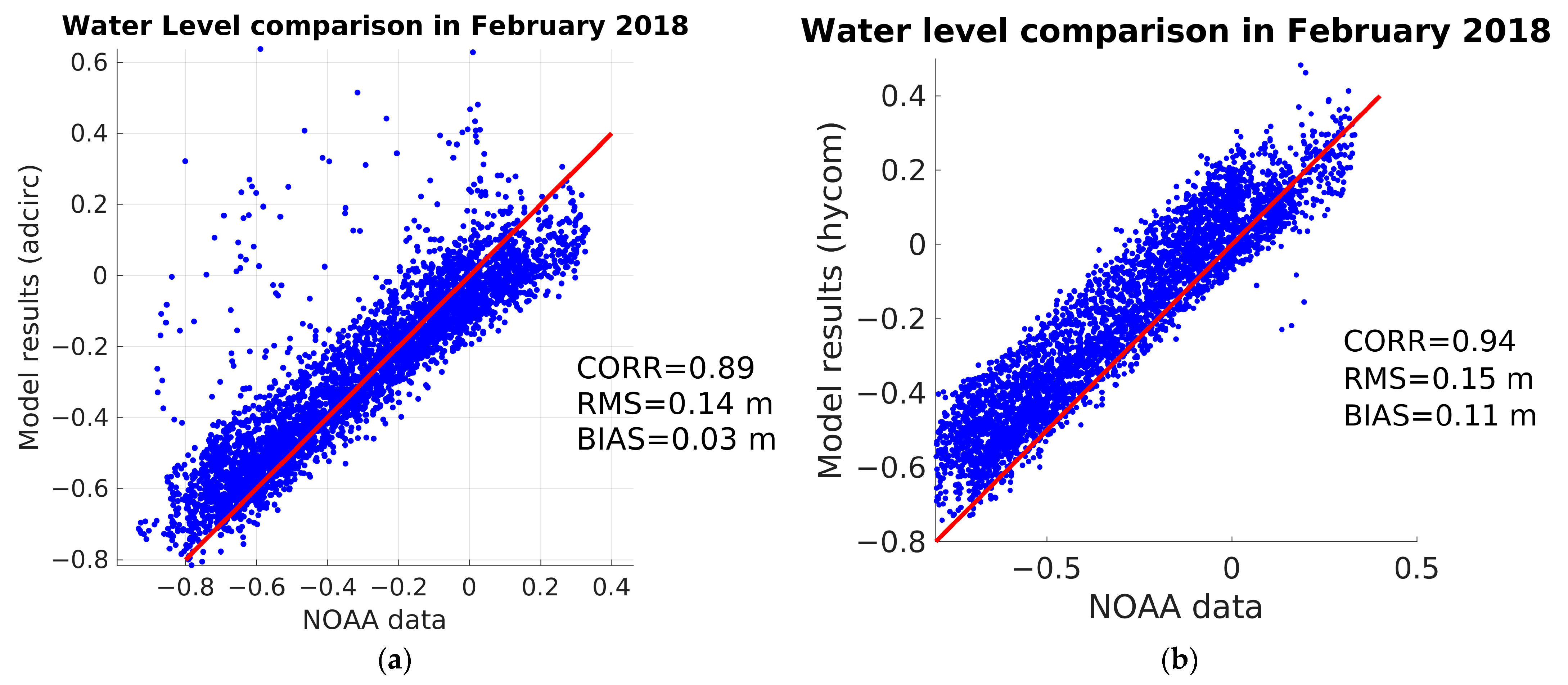
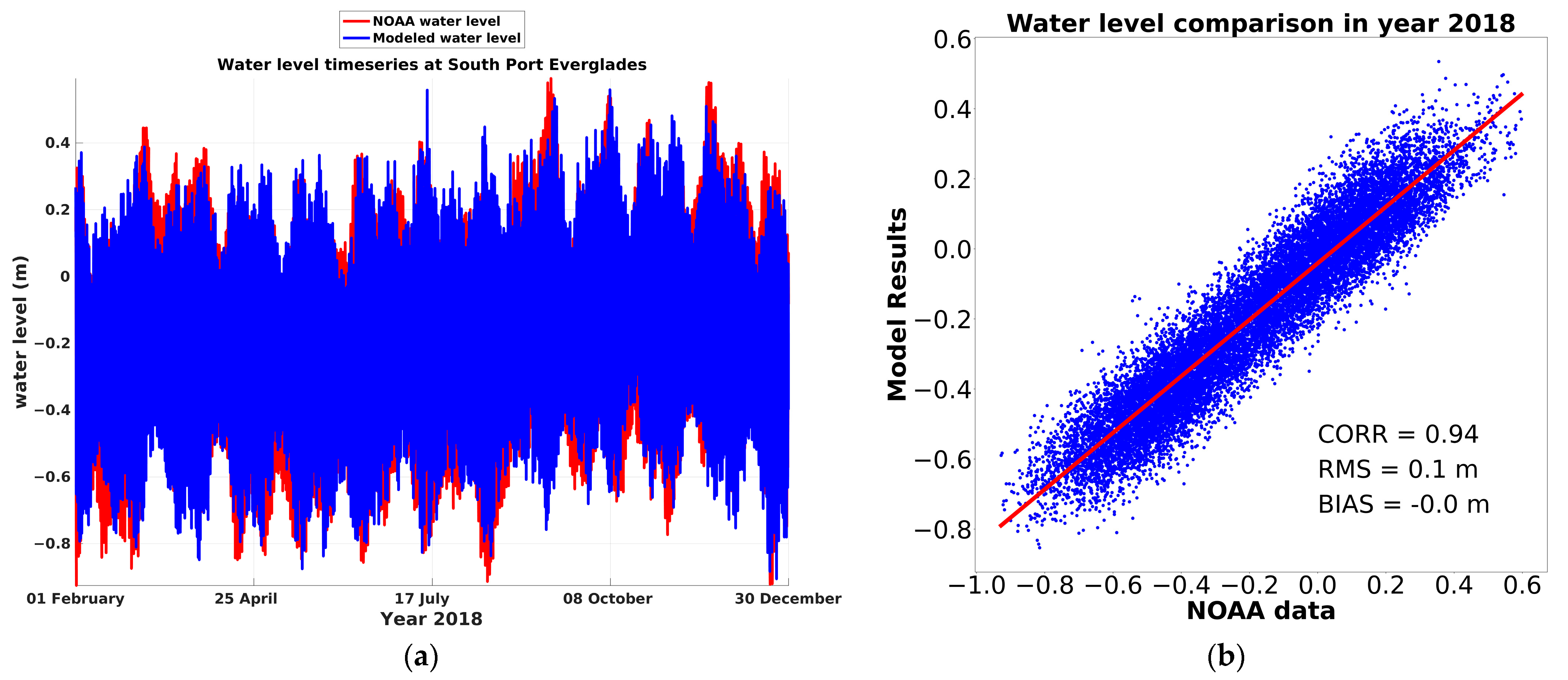
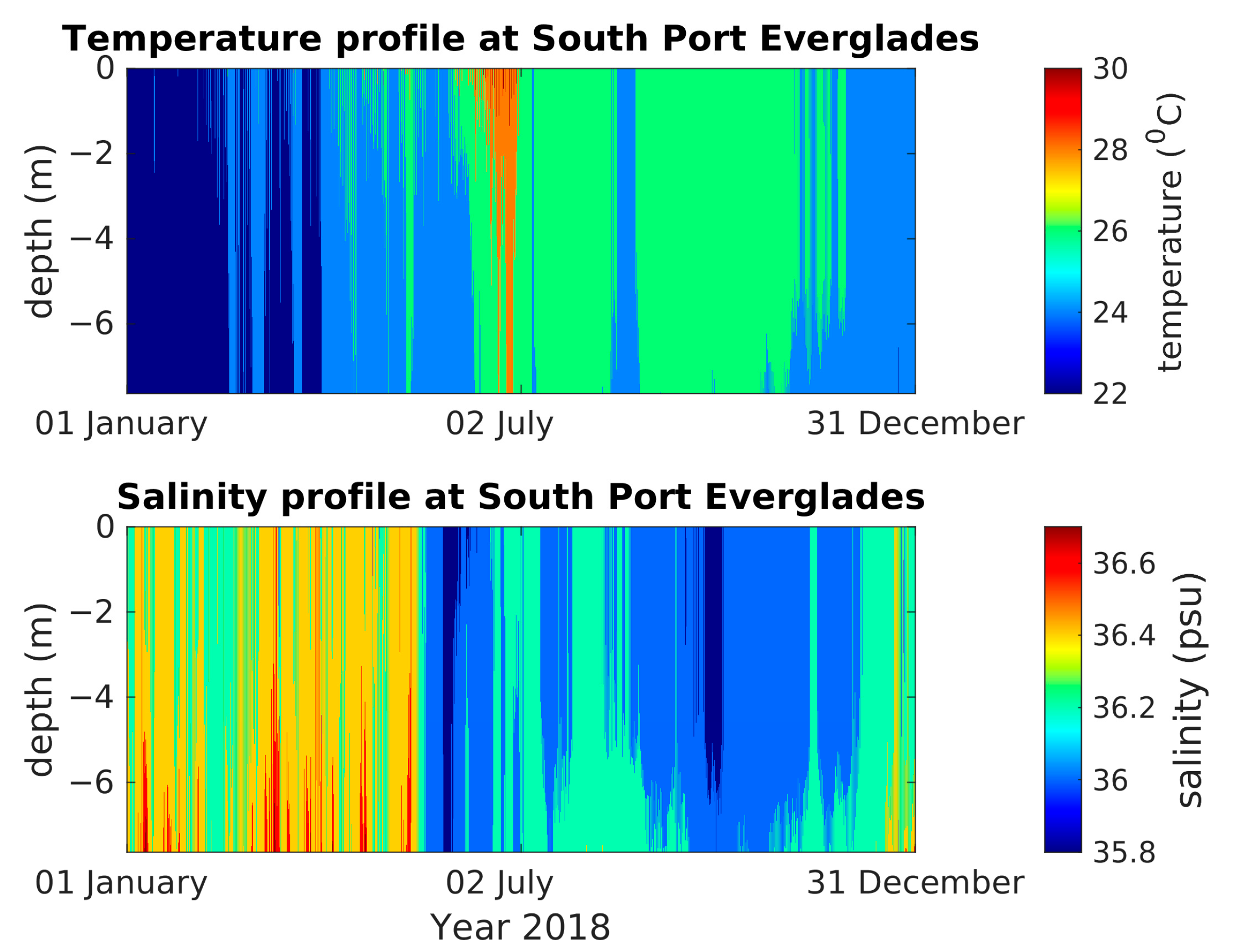
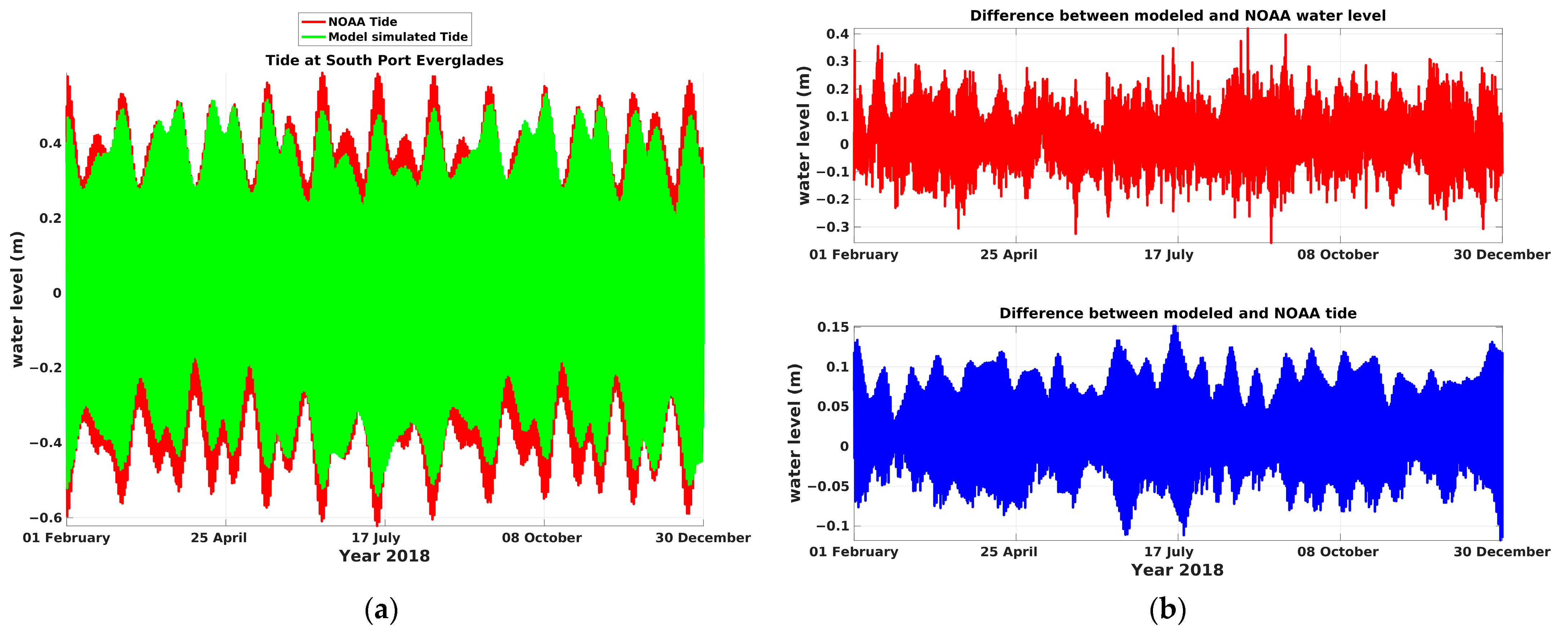

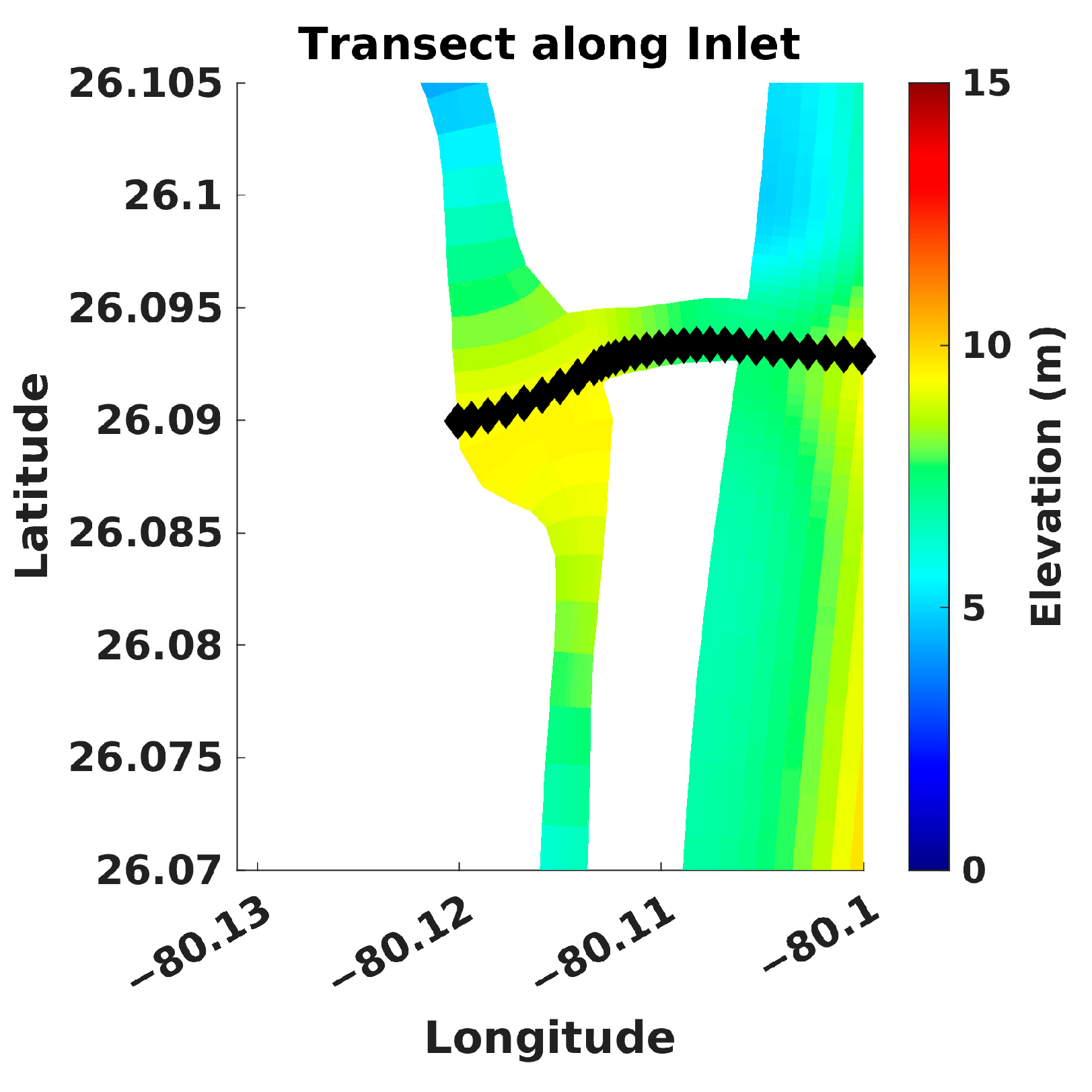
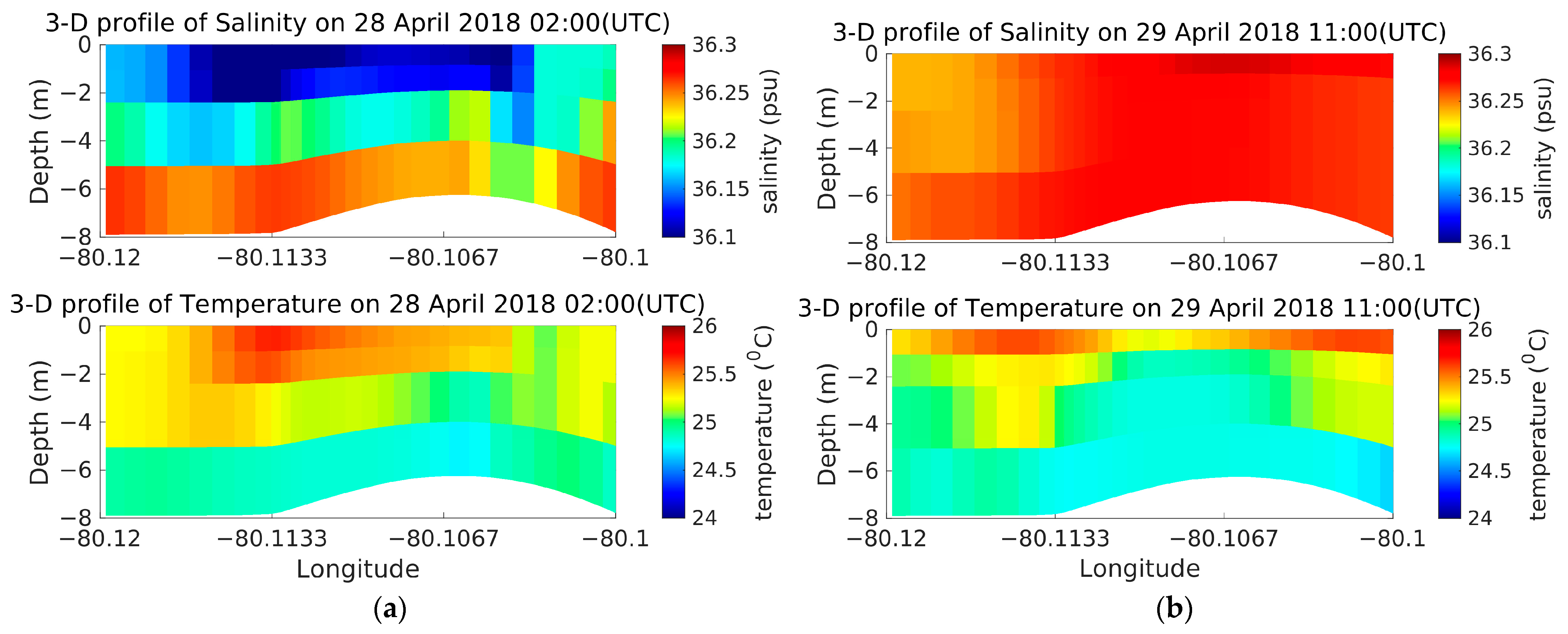

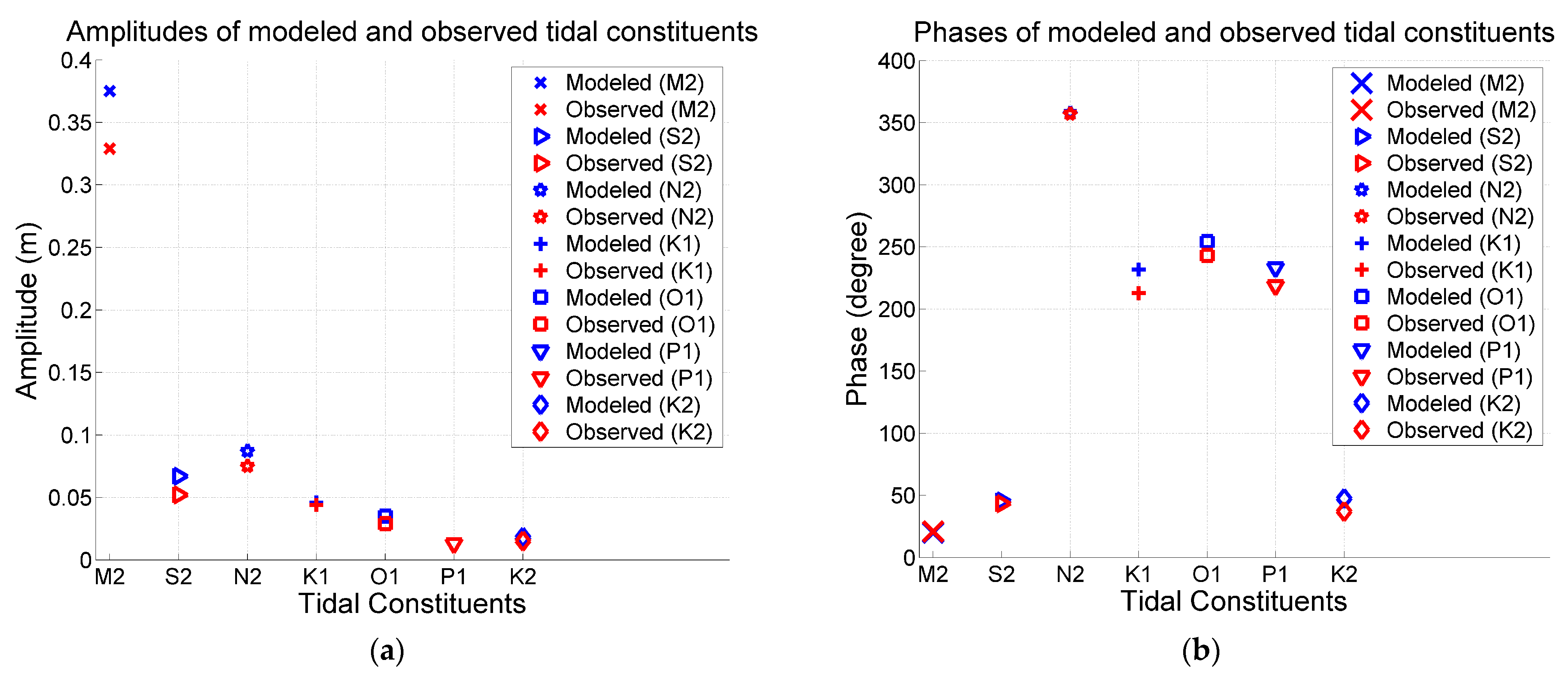

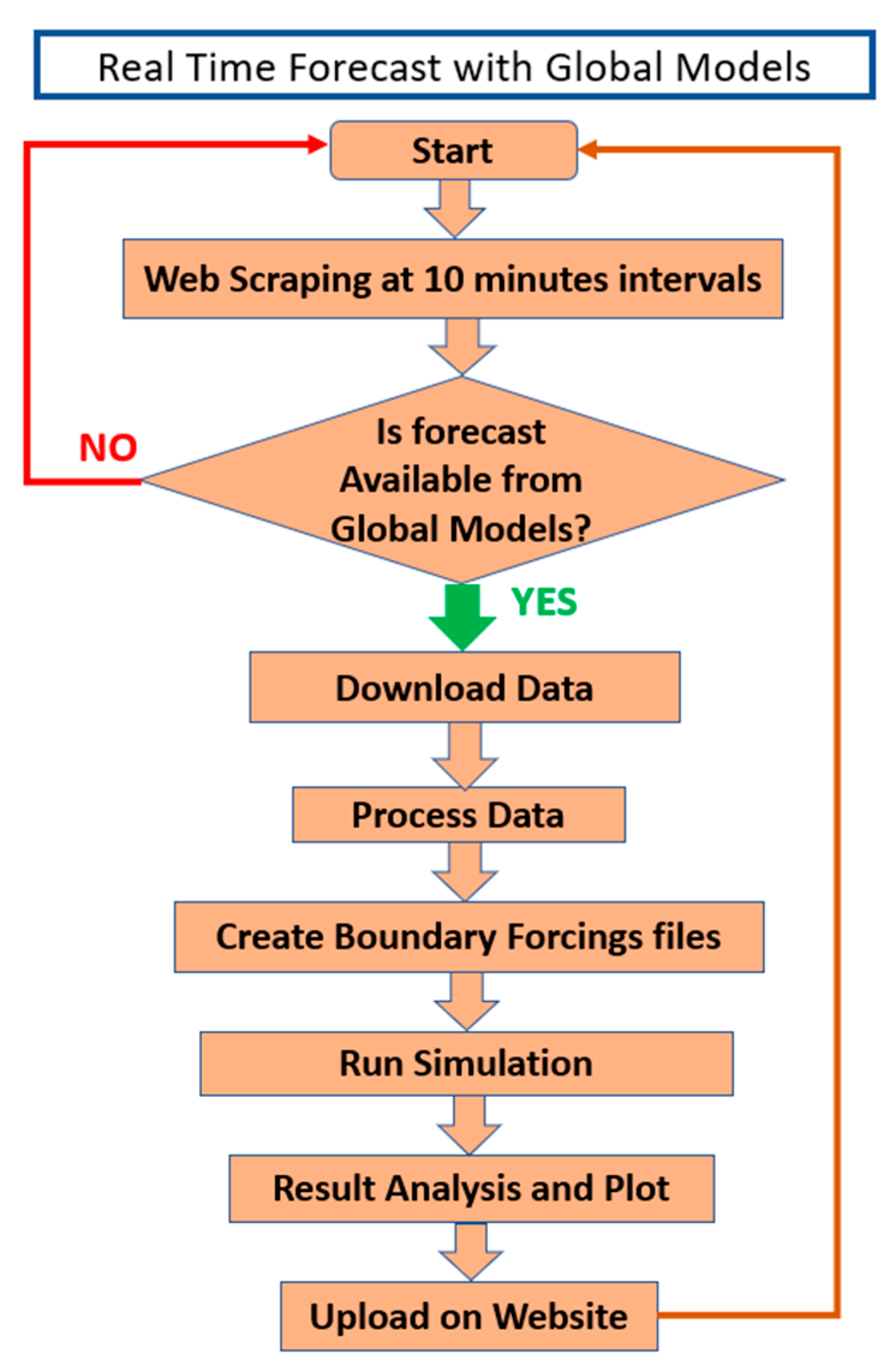

| Data | Source Name | URL | Resolution |
|---|---|---|---|
| Water level, salinity, and temperature | HYCOM | https://www.hycom.org (accessed on 24 March 2023) | 0.040 |
| Evaporation, radiation heat flux, relative humidity, air temperature, u, and v comp of wind (hindcast) | NARR | https://psl.noaa.gov/data/gridded/data.narr.html (accessed on 6 December 2020) | 32 km |
| Topography | NCEI NOAA | https://www.ncei.noaa.gov (accessed on 25 April 2018) | 0.0055560 |
| Radiation heat flux, relative humidity, air temperature, u, and v comp of wind (forecast data) | NAM | https://ftp.ncep.noaa.gov/data/nccf/com/nam/prod/ (accessed on 24 March 2023) | 12 km |
| Water level and harmonic constituents | NOAA BUOY | https://tidesandcurrents.noaa.gov/stationhome.html?id=8722956 (accessed on 5 June 2018) | Time series |
Disclaimer/Publisher’s Note: The statements, opinions and data contained in all publications are solely those of the individual author(s) and contributor(s) and not of MDPI and/or the editor(s). MDPI and/or the editor(s) disclaim responsibility for any injury to people or property resulting from any ideas, methods, instructions or products referred to in the content. |
© 2023 by the authors. Licensee MDPI, Basel, Switzerland. This article is an open access article distributed under the terms and conditions of the Creative Commons Attribution (CC BY) license (https://creativecommons.org/licenses/by/4.0/).
Share and Cite
Habib, M.A.; Zarillo, G.A. Construction of a Real-Time Forecast Model for Coastal Engineering and Processes Nested in a Basin Scale Model. J. Mar. Sci. Eng. 2023, 11, 1263. https://doi.org/10.3390/jmse11071263
Habib MA, Zarillo GA. Construction of a Real-Time Forecast Model for Coastal Engineering and Processes Nested in a Basin Scale Model. Journal of Marine Science and Engineering. 2023; 11(7):1263. https://doi.org/10.3390/jmse11071263
Chicago/Turabian StyleHabib, Md Ahsan, and Gary A Zarillo. 2023. "Construction of a Real-Time Forecast Model for Coastal Engineering and Processes Nested in a Basin Scale Model" Journal of Marine Science and Engineering 11, no. 7: 1263. https://doi.org/10.3390/jmse11071263
APA StyleHabib, M. A., & Zarillo, G. A. (2023). Construction of a Real-Time Forecast Model for Coastal Engineering and Processes Nested in a Basin Scale Model. Journal of Marine Science and Engineering, 11(7), 1263. https://doi.org/10.3390/jmse11071263





